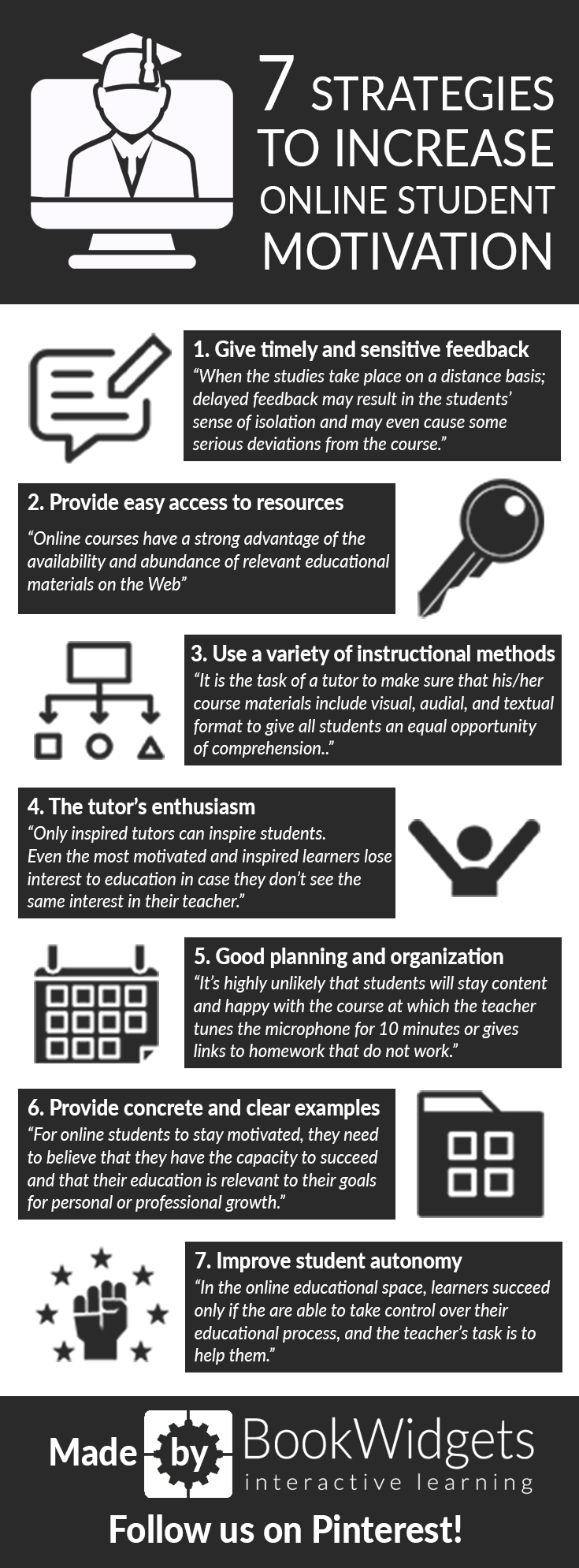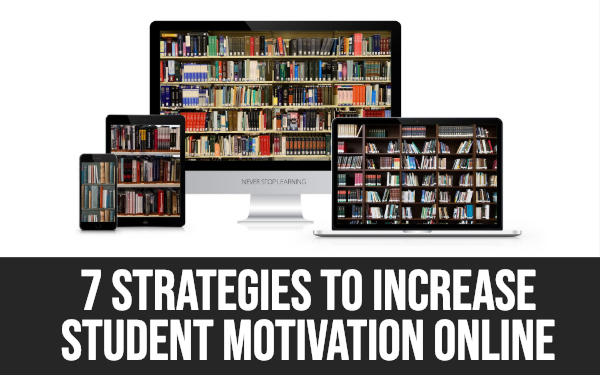Best 7 strategies to increase student motivation online
 July Mayer —
July Mayer —
Are you struggling to involve your online students and motivate them? Here are some workable strategies to get everyone engaged.
The third millennium is an epoch of online learning. What seemed to be unbelievable and sophisticated just a decade ago is a commonplace routine today. Millions of students have embraced the potential of distance learning, enabling them to master any skill and profession from the convenience of their location.
Even more people widen their horizons with a variety of online programs: they learn English, master programming, or flip the classroom with BookWidgets exercises.
But the problem is that online learning differs from face-to-face instruction profoundly. While staying in a classroom and working with a teacher and other classmates, students get much more involved in the process. Working from home is less demanding in terms of attention and focus, so many online learners fail before reaping any progress from their online course. How to keep students motivated in an online environment?
Here’s a cheat sheet for teachers to minimize dropout from their courses and help students succeed.
7 tips to keep up student engagement in digital courses
1. Give timely and sensitive feedback
 Feedback is critical in online learning. When the educational process takes place in a classroom, the teacher has numerous opportunities to give feedback in real time, thus streamlining students and pinpointing their mistakes early. When the studies take place on a distance basis, delayed feedback may result in the students’ sense of isolation and may even cause some serious deviations from the course.
Feedback is critical in online learning. When the educational process takes place in a classroom, the teacher has numerous opportunities to give feedback in real time, thus streamlining students and pinpointing their mistakes early. When the studies take place on a distance basis, delayed feedback may result in the students’ sense of isolation and may even cause some serious deviations from the course.
In the 21st century, technology is highly helpful for tutors, and you can make use of some programs to give sensitive feedback right at the time when your students require it:
- Share verbal feedback with students via a simple Vocaroo-powered audio podcast
- Provide video feedback with screen captions with the help of Jing
- Arrange videoconferences with Zoom to discuss important issues and give virtual feedback sessions
- Create activities with tools that have feedback built-in, such as BookWidgets
2. Provide easy access to resources
 Online courses have a strong advantage of the availability and abundance of relevant educational materials on the Web. Thus, your task as a tutor is to provide guidance on further reading and studying by giving links to free, easily accessible resources. In such a way, you will make sure that students will always access them and will get all information you need.
Online courses have a strong advantage of the availability and abundance of relevant educational materials on the Web. Thus, your task as a tutor is to provide guidance on further reading and studying by giving links to free, easily accessible resources. In such a way, you will make sure that students will always access them and will get all information you need.
This is easily achievable if you give links to:
- Wikipedia as the starting point of learning something
- YouTube channels with useful educational material
- A BookWidgets webquest with online widgets (or exercises), links to webpages, video materials and much more. You can even embed Wikipedia pages and YouTube Videos!
- Your personal resources carefully prepared and uploaded to the course website, accessible to enrollees of your course - Tip: Use a Google Drive!
However, always make sure that you direct students towards materials that are free from copyright or are officially distributed in the Web with consent of their owner. Too much material is illegally publicized in the Internet, so using such materials may be an academically unfair practice. If you want to share images that are free of copyright, you can find them right here.
3. Use a variety of instructional methods
 People are not universal; some students perceive information in the visual form better, while other are audial personalities. Students have different cognitive styles, and the real-life classroom gives a richness of educational opportunities for students of all kinds, but in online learning, some components may lack, leaving some students beyond the scope of effective studying. Thus, it is the task of a tutor to make sure that his/her course materials include visual, audial, and textual format to give all students an equal opportunity of comprehension.
People are not universal; some students perceive information in the visual form better, while other are audial personalities. Students have different cognitive styles, and the real-life classroom gives a richness of educational opportunities for students of all kinds, but in online learning, some components may lack, leaving some students beyond the scope of effective studying. Thus, it is the task of a tutor to make sure that his/her course materials include visual, audial, and textual format to give all students an equal opportunity of comprehension.
In practice, you can achieve that variety by enriching every lesson with:
- Textual information in the lesson
- A video explaining and illustrating key points
- A discussion board or live session with students
- A PowerPoint presentation with core material
Here’s an example. You can share these different exercises with your students in a BookWidgets webquest widget.
4. The tutor’s enthusiasm
 This one is maybe a cliché but we all know it is the truth: only inspired tutors can inspire students. Even the most motivated and inspired learners lose interest to education in case they don’t see the same interest in their teacher, so it’s the critical role of the tutor to serve as a living example of passion towards the subject.
This one is maybe a cliché but we all know it is the truth: only inspired tutors can inspire students. Even the most motivated and inspired learners lose interest to education in case they don’t see the same interest in their teacher, so it’s the critical role of the tutor to serve as a living example of passion towards the subject.
Make interesting lectures, arrange emotional and involved discussions, repeatedly link the course material to real life, and you will see even the struggling learner pursue the course with stubbornness and resilience. This will surely be a rewarding experience!
You could for example use memes in your lessons or provide different options for students with different interests.
5. Good planning and organization
 A real-life classroom affords some improvisation because of the numerous kinds of activities that groups can conduct. However, in the online space, good planning and organization are the clue to effective learning and student interest.
A real-life classroom affords some improvisation because of the numerous kinds of activities that groups can conduct. However, in the online space, good planning and organization are the clue to effective learning and student interest.
It’s highly unlikely that students will stay content and happy with the course at which the teacher tunes the microphone for 10 minutes or gives links to homework that do not work. So, planning is vital in both technical and educational terms to make the learning process smooth and students – satisfied.
An excellent way to guarantee flawless, engaging organization of your online lessons is to rely on modern technology for lesson design (such as BookWidgets). You also reap benefits in the form of quicker lesson planning, less time spent on grading, and the use of contemporary ICT in the course.
If you want to boost your productivity as a teacher, you might want to take a look at these great productivity apps.
6. Provide concrete and clear examples
 Even the most theoretical fields of knowledge can be tied to specific real-life situations, which gives ultimate meaning to studies.
Even the most theoretical fields of knowledge can be tied to specific real-life situations, which gives ultimate meaning to studies.
Research suggests that for online students to stay motivated, they need to believe that they have the capacity to succeed (that is, possess competence) and that their education is relevant to their goals for personal or professional growth.
By giving concrete examples and linking theory to practice, teachers ensure the relatedness of their course, which has a long-term positive impact on motivation.
7. Improve student autonomy
 Finally, it is critical to stay true to the essence of online learning, also called self-directed learning. In the online educational space, learners succeed only if the are able to take control over their educational process, and the teacher’s task is to help them.
Finally, it is critical to stay true to the essence of online learning, also called self-directed learning. In the online educational space, learners succeed only if the are able to take control over their educational process, and the teacher’s task is to help them.
You can improve student autonomy in the following ways:
- by creating the calendar of assignments and the schedule of materials to be studied for the course (for students to schedule their work on the course materials flexibly without being given a piece of data every week) - Here’s an example.
- by involving students into independent goal-setting at the start of the course to take the full ownership of the process
- by presenting students to new educational scenarios and situations, thus teaching them to make independent decisions.
As you can see, online learning differs from a traditional classroom, but the times are changing, and we cannot teach by the old standards, ignoring the students’ needs of today. Education is undergoing a fundamental transformation, so helping students succeed requires the change of teachers’ mindset. Adapt to the technological requirements, make your online courses accessible and convenient, and you will reap rewards in the form of students’ progress and gratitude.

About the author
July Mayer is a freelance writer who lives in with her husband, 7-years old son and a medium-sized dog. Before she became a freelance writer, she experimented with various occupations: marketing, dog-training, scientificating… But her favorite job is the one she’s now doing full time - writing articles.


